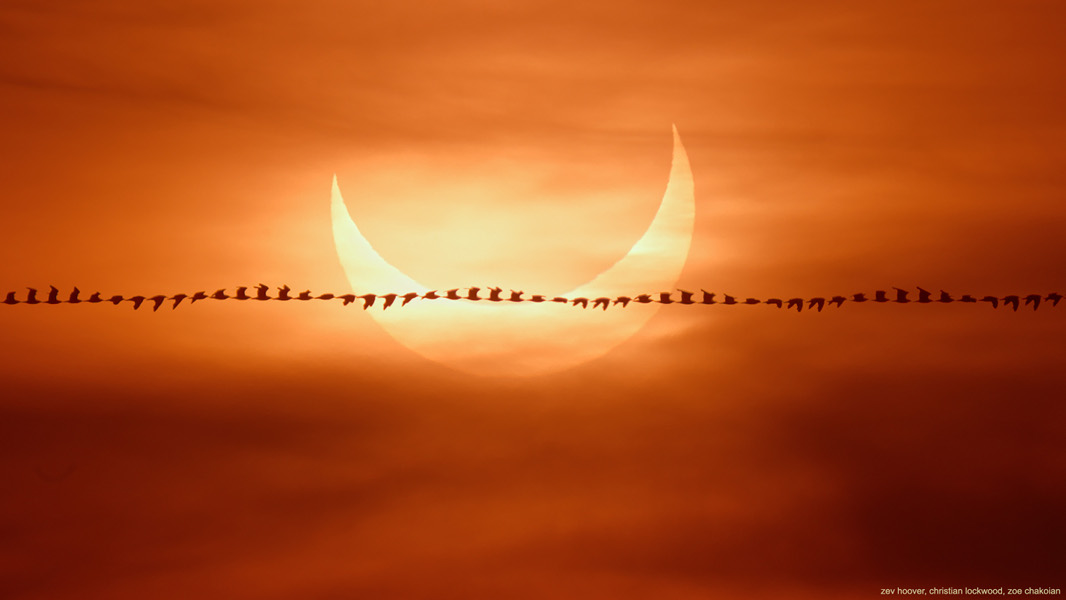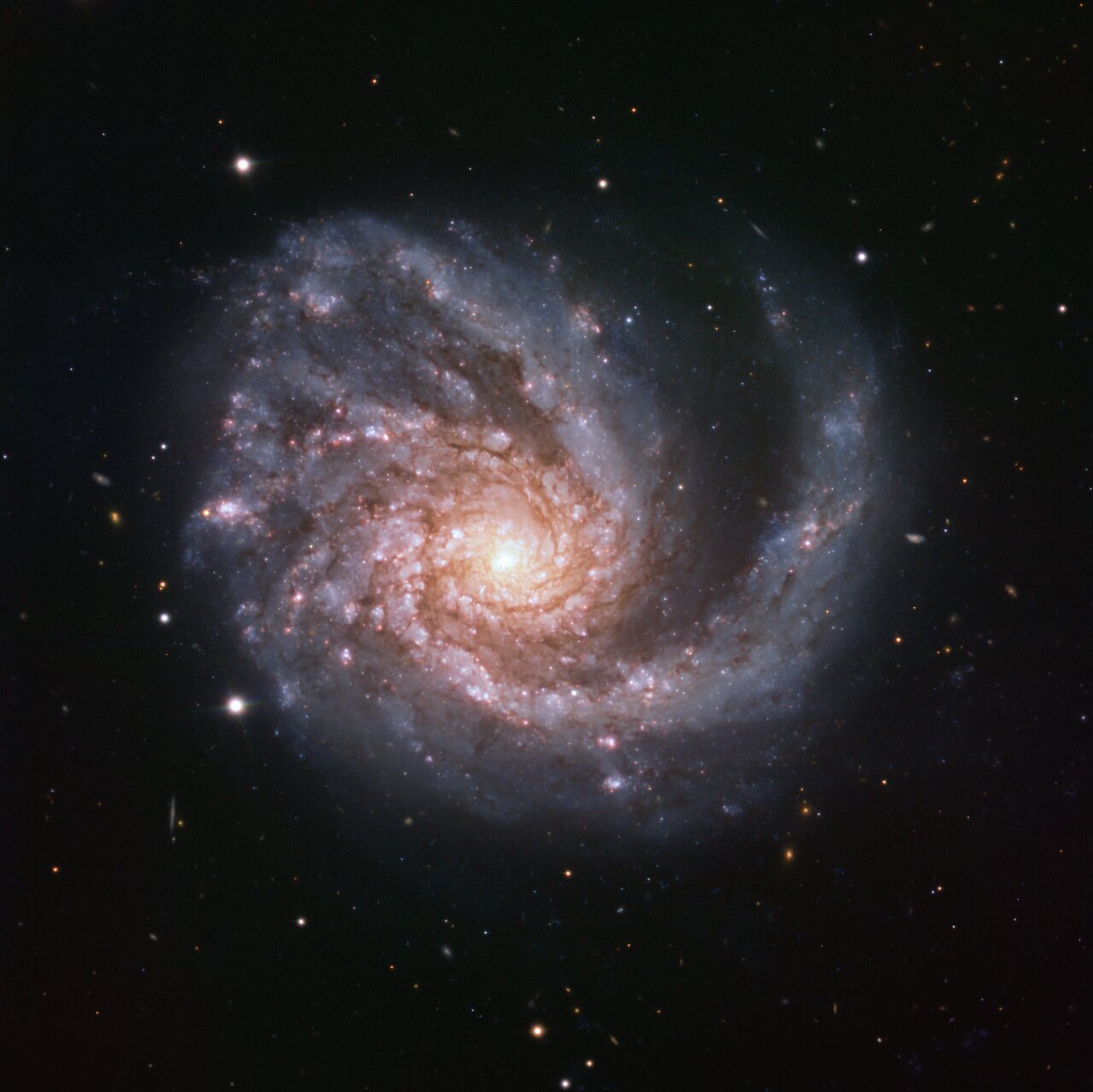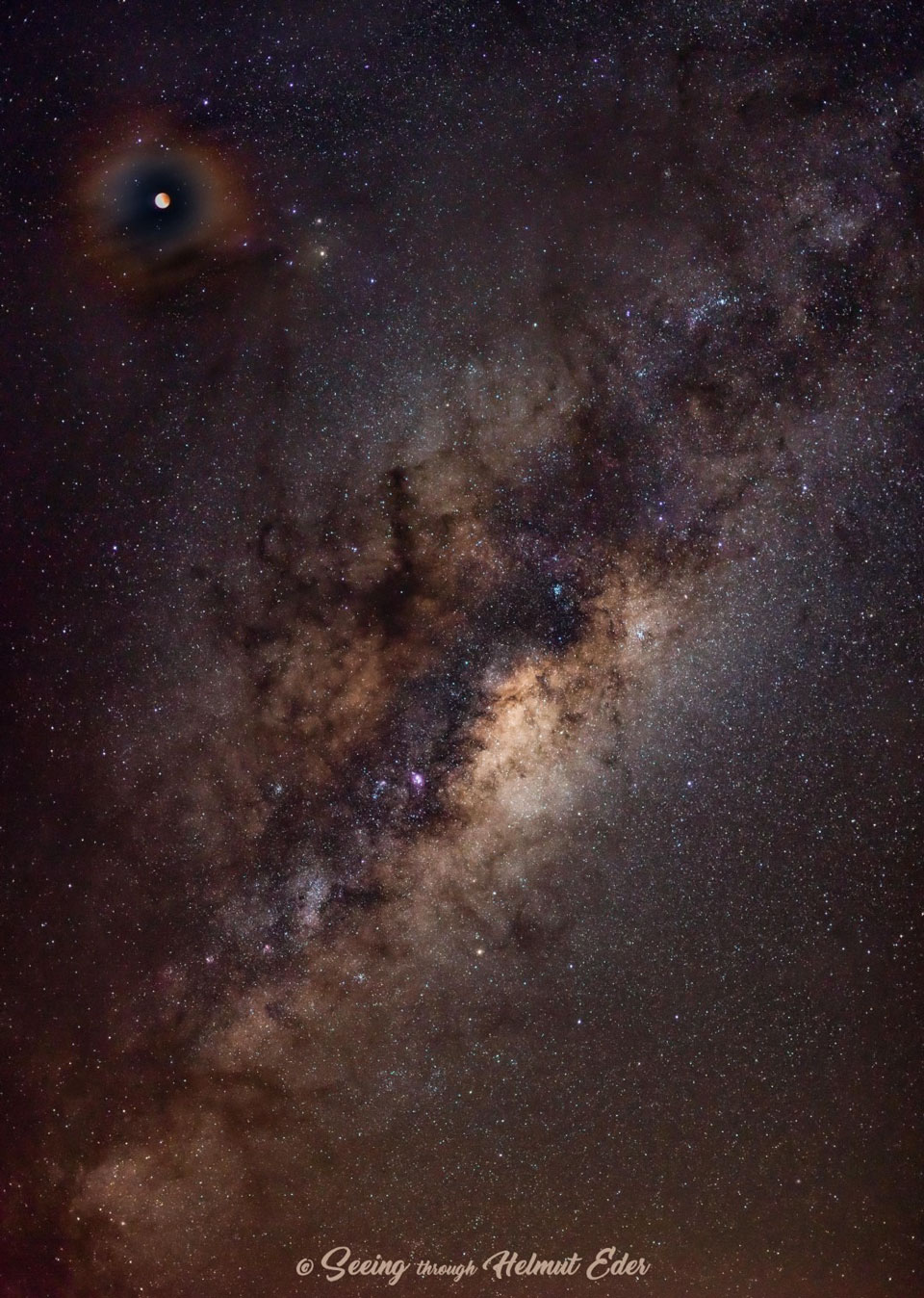Blog
On June 10 a New Moon passed in front of the Sun. In silhouette only two days after reaching apogee, the most distant point in its elliptical orbit, the Moon’s small apparent size helped create an annular solar eclipse. The brief but spectacular annular phase of the eclipse shows a bright solar disk as a ring of fire when viewed along its narrow, northerly shadow track across planet Earth. Cloudy early morning skies along the US east coast held gorgeous views of a partially eclipsed Sun though. Rising together Moon and Sun are captured in a sequence of consecutive frames near maximum eclipse in this digital composite, seen from Quincy Beach south of Boston, Massachusetts. The serendipitous sequence follows the undulating path of a bird in flight joining the Moon in silhouette with the rising Sun.

Clarence Smith (June 11, 1904 – March 15, 1929), better known as Pinetop Smith or Pine Top Smith, was an American boogie-woogie style blues pianist. His hit tune “Pine Top’s Boogie Woogie” featured rhythmic “breaks” that were an essential ingredient of ragtime music, but also a fundamental foreshadowing of rock & roll. The song was also the first known use of the term “boogie woogie” on a record, and cemented that term as the moniker for the genre.
Smith was born to an African American family in Troy, Alabama and raised in Birmingham, Alabama. He received his nickname as a child from his liking for climbing trees. In 1920 he moved to Pittsburgh, Pennsylvania, where he worked as an entertainer before touring on the T. O. B. A.vaudeville circuit, performing as a singer and comedian as well as a pianist. For a time he worked as accompanist for blues singer Ma Rainey and Butterbeans and Susie.
In the mid-1920s he was recommended by Cow Cow Davenport to J. Mayo Williams at Vocalion Records, and in 1928 he moved, with his wife and young son, to Chicago, Illinois to record. For a time he, Albert Ammons, and Meade Lux Lewis lived in the same rooming house.
more...Bernard Lee “Pretty” Purdie (born June 11, 1939) is an American drummer, and an influential R&B, soul, funk, and jazz musician. He is known for his precise musical time keeping and his signature use of triplets against a half-time backbeat: the “Purdie Shuffle.” He was inducted into the Modern Drummer Hall of Fame in 2013.
Purdie recorded Soul Drums (1968) as a band leader and although he went on to record Alexander’s Ragtime Band, the album remained unreleased until Soul Drums was reissued on CD in 2009 with the Alexander’s Ragtime Band sessions. Other solo albums include Purdie Good!(1971), Soul Is… Pretty Purdie (1972) and the soundtrack for the blaxploitation film Lialeh (1973).
In the mid-1990s he was a member of The 3B’s, with Bross Townsend and Bob Cunningham.
Purdie was born on June 11, 1939 in Elkton, Maryland, US, the eleventh of fifteen children. At an early age he began hitting cans with sticks and learned the elements of drumming techniques from overhearing lessons being given by Leonard Heywood. He later took lessons from Heywood and played in Heywood’s big band. Purdie’s other influences at that time were Papa Jo Jones, Buddy Rich, Gene Krupa, Joe Marshall, Art Blakey,[10] as well as Cozy Cole, Sticks Evans, Panama Francis, Louis Bellson, and Herbie Lovelle.
In 1961, he moved from his home town of Elkton, Maryland, to New York City. There he played sessions with Mickey and Sylvia and regularly visited the Turf Club on 50th and Broadway, where musicians, agents, and promoters met and touted for business. It was during this period that he played for the saxophonist Buddy Lucas, who nicknamed him ‘Mississippi Bigfoot’. Eventually Barney Richmond contracted him to play session work. In a 1978 interview, Purdie claimed to have added drum overdubs to “several [tracks] of the Beatles’ Hamburg recording” with Tony Sheridan, including “Ain’t She Sweet”, “Take Out Some Insurance On Me Baby” and “Sweet Georgia Brown”, to give them a punchier sound for the US market. He can be seen drumming for the house band at Murray the K’s 1965 Brooklyn Fox show excerpts of which were shown on CBS that year.
more...Hazel Dorothy Scott (June 11, 1920 – October 2, 1981) was a Trinidadian-born jazz and classical pianist, singer, and actor. She was a critically acclaimed performing artist and an outspoken critic of racial discrimination and segregation. She used her influence to improve the representation of Black Americans in film.
Born in Port of Spain, Scott moved to New York City with her mother at the age of four. Scott was a child musical prodigy, receiving scholarships to study at the Juilliard School when she was eight. In her teens, she performed in a jazz band. She also performed on the radio.
She was prominent as a jazz singer throughout the 1930s and 1940s. In 1950, she became the first black American to host her own TV show, The Hazel Scott Show. Her career in America faltered after she testified before the House Un-American Activities Committee in 1950 during the McCarthy era. Scott subsequently moved to Paris in 1957 and began performing in Europe, not returning to the United States until 1967.
Born in Port of Spain, Trinidad and Tobago, on June 11, 1920, Hazel Dorothy Scott was the only child of R. Thomas Scott, a West African scholar from Liverpool, England, and Alma Long Scott, a classically trained pianist, and music teacher. In 1924, the family moved from Trinidad to the United States and settled in Harlem, New York City. By that time, Scott could play anything she heard on the piano. With her mother’s guidance and training, she mastered advanced piano techniques and was labeled a child prodigy. A few years later, when Scott was eight years old, Professor Paul Wagner of the Juilliard School of Music accepted her as his own student. In 1933, her mother organized her own “Alma Long Scott’s All-Girl Jazz Band,” where Scott played the piano and trumpet.
more...Sheldon Manne (June 11, 1920 – September 26, 1984), professionally known as Shelly Manne, was an American jazz drummer. Most frequently associated with West Coast jazz, he was known for his versatility and also played in a number of other styles, including Dixieland, swing, bebop, avant-garde jazz and fusion, as well as contributing to the musical background of hundreds of Hollywood films and television programs.
Manne’s father and uncles were drummers. In his youth he admired many of the leading swing drummers of the day, especially Jo Jones and Dave Tough. Billy Gladstone, a colleague of Manne’s father and the most admired percussionist on the New York theatrical scene, offered the teenage Shelly tips and encouragement. From that time, Manne rapidly developed his style in the clubs of 52nd Street in New York in the late 1930s and 1940s. His first professional job with a known big band was with the Bobby Byrne Orchestra in 1940.[4] In those years, as he became known, he recorded with jazz stars like Coleman Hawkins, Charlie Shavers, and Don Byas. He also worked with a number of musicians mainly associated with Duke Ellington, like Johnny Hodges, Harry Carney, Lawrence Brown, and Rex Stewart. In 1942, during World War II, Manne joined the Coast Guard and served until 1945. In 1943, Manne married a Rockette named Florence Butterfield (known affectionately to family and friends as “Flip”). The marriage would last 41 years, until the end of Manne’s life. When the bebop movement began to change jazz in the 1940s, Manne loved it and adapted to the style rapidly, performing with Dizzy Gillespie and Charlie Parker.
https://www.youtube.com/watch?v=Ukw7qTawjfY
more...Tientos, a slow cante jondo music and dance in a four-count rhythm, was first developed by the singer Enrique el Mellizo (1848 -1906) as an expressive variation of the Tangos. Poet Federico García Lorca considered the Tientos to be almost liturgical in its solemnity. Traditional Tientos lyrics – letras – set a dark mood, and have to do with loss, unrequited love, imprisionment, longing for freedom and other serious messages. Dancers strive to capture this mood in their solos. The most notable aspect of the slow Tientos tempo is the beat structure. Where the first beat in Tangos is subdued, it is strongly emphasized in the Tientos, as is the “and” of the second beat.
Although many variations are possible, the most basic form of the Tientos is as follows :
Guitar introduction – The guitarist sets the basic tempo and key
Temple – The singer sings fragments – estribillos – (le le, la, etc.) to establish thekey, pulse and mood of the piece.
The dancer’s llamada – call/cue the guitarist performs double time here. The dancer generally performs footwork.
First Letra – The singer sings the first verse, and the dancer interprets thisimpressionistically and rhythmically.
After the 1st line of the song, the singer may take a 1 or 2 compás break – the respira – and the dancer usually inserts footwork here.
Guitar falseta – a short melodic phrase that the dancer interprets lyrically.
First Escobilla – The dancer’s 1st prolonged footwork section. This ends with a llamada call in the 2nd verse.
Second Letra – Similar or identical to the 1st verse.
Second Escobilla = The dancer’s final long footwork section.
Macho – It is common for a flamenco song to end in a faster song/rhythm, and it is usually the Tangos for Tientos. The most traditional Tangos lyrics performed here are the song, “Triana.”
more...This ESO Picture of the Week features a galaxy named both NGC 4254 and Messier 99, a beautiful cosmic spectacle located in the constellation of Coma Berenices (Berenice’s Hair). Messier 99 is special, owing to its classification as a grand design spiral galaxy: a kind of galactic architecture featuring strong, prominent, well-defined arms that wrap clearly around the galaxy’s centre. Only around 10 percent of all spirals are of the grand design variety, making objects like Messier 99 somewhat uncommon. The justification behind Messier 99’s categorisation is clear in this image; bright, swirling arms carve through the dark surrounding space, and are easily identifiable as a number of different, coherent structures. This image was created as part of the ESO Cosmic Gems programme, an outreach initiative to produce images of interesting, intriguing or visually attractive objects using ESO telescopes, for the purposes of education and public outreach. The programme makes use of telescope time that cannot be used for science observations. All data collected may also be suitable for scientific purposes, and are made available to astronomers through ESO’s science archive.

Charnett Moffett (born June 10, 1967) is an American jazz bassist.
Moffett started playing bass in the family band, touring the Far East in 1975 at the age of eight. In the mid-1980s he played with Wynton Marsalis and Branford Marsalis. In 1987 he recorded his debut album Netman for Blue Note Records. He has worked with Art Blakey, Ornette Coleman, Pharoah Sanders, Dizzy Gillespie, Ellis Marsalis, Sonny Sharrock, Stanley Jordan, Wallace Roney. Arturo Sandoval, Courtney Pine, David Sanborn, David Sánchez, Dianne Reeves, Frank Lowe, Harry Connick, Jr., Herbie Hancock, Joe Henderson, Kenny Garrett, Kenny Kirkland, Kevin Eubanks, Lew Soloff, Manhattan Jazz Quintet, Melody Gardot, Mulgrew Miller and Tony Williams.
Charnett Moffett attended Fiorello H. LaGuardia High School of Music & Art and Performing Arts in New York City and later studied at Mannes College of Music and the Juilliard School of Music. In 1983, he played on saxophonist Branford Marsalis‘ debut as a leader, Scenes in the City, and the following year he joined trumpeter Wynton Marsalis’ quintet, appearing on 1985’s Grammy-winning Black Codes (From the Underground). During the 1980s, Moffett also worked with Stanley Jordan, appearing on the innovative guitarist’s best-selling 1985 Blue Note debut, Magic Touch, as well as two Blue Note albums with drummer Tony Williams’ quintet: 1987’s Civilization and 1988’s Angel Street. In 1987, Moffett signed with Blue Note Recordsand debuted as a leader that year with his first of three albums for Blue Note, NetMan (1987) which featured Michael Brecker, Kenny Kirkland and Al Foster. His second Blue Note release, Beauty Within (1989) was a family affair featuring his father Charles Moffett on drums, older brothers Mondre Moffett on trumpet, Charles Moffett, Jr on tenor sax, Codaryl Moffett on drums, and his sister Charisse on vocals. Also featured were Kenny Garrett on alto saxophone, and Stanley Jordan on guitar. HIs third Blue Note release, Netman (1991), produced by Kenny Kirkland, especially focused on Moffett’s piccolo bass and electric bass work.
more...Max Alfred “Maxi” Elliott (born 10 June 1961), known by his stage name Maxi Priest, is a British reggae vocalist of Jamaican descent. He is best known for singing reggae music with an R&B influence, otherwise known as reggae fusion. He was one of the first international artists to have success in this genre, and one of the most successful reggae fusion acts of all time.
Maxi Priest was born in Lewisham, London, the second youngest of nine brothers and sisters. His parents had moved to England from Jamaica to provide more opportunity for their family and he grew up listening to gospel, reggae, R&B, and pop music. He first learned to sing in church, encouraged by his mother, who was a Pentecostal missionary. Maxi grew up listening to Jamaican greats such as Dennis Brown, John Holt, Ken Boothe and Gregory Isaacs as well as singers like Marvin Gaye, Al Green, the Beatles, Phil Collins and Frank Sinatra.
As a teenager, he lifted speaker boxes for the Jah Shaka and Negus Negast sound-systems. He was a founder member of Saxon Studio International, and it was with Saxon that Maxi began performing at neighbourhood youth clubs and house parties.
His music is sometimes closer to R&B and pop than to reggae. His cousin, Jacob Miller, a reggae icon, was the frontman in the popular reggae group Inner Circle.
more...M.S. Gopalakrishnan, a.k.a. MSG, (10 June 1931 – 3 January 2013) was a violinist in the field of Carnatic music. He is commonly grouped with Lalgudi Jayaraman and T.N.Krishnan as part of the violin-trinity of Carnatic Music. He was awarded the Madras Music Academy‘s Sangeetha Kalanidhi in 1997. He was a recipient of the Padma Bhushan, Padma Shri, Kalaimamani, Sangeetha Kalanidhi and Sangeet Natak Akademi awards.
Gopalakrishnan was born in Mylapore, Chennai, India, and was taught violin by his father, Parur Sundaram Iyer, who was well versed in both Carnatic and Hindustani systems of Indian classical music. He learned both systems from his father, with whom he gave his first performance when he was 8 years old. He also drew great inspiration from the legendary violinist Sri Dwaram Venkataswamy Naidu.
He has played the violin for over fifty years as a soloist and accompanist, having accompanied Omkarnath Thakur and D. V. Paluskar, and has toured Australia, the US, the UK, the Netherlands, South Africa, Malaysia, and Hong Kong. His daughter, Dr M. Narmadha, is also a violinist.
more...João Gilberto (born João Gilberto Prado Pereira de Oliveira – Portuguese: [ʒuˈɐ̃w ʒiwˈbɛʁtu]; 10 June 1931 – 6 July 2019), was a Brazilian singer, songwriter, and guitarist, who was a pioneer of the musical genre of bossa nova in the late 1950s. Around the world he was often called “father of bossa nova”; in his native Brazil, he was referred to as “O Mito” (“The Legend”).
João Gilberto was born in Juazeiro, Bahia, the son of Joviniano Domingos de Oliveira, a wealthy merchant, and Martinha do Prado Pereira de Oliveira. He lived in his native city until 1942, when he began to study in Aracaju, Sergipe, returning to Juazeiro in 1946. At the age of 14, Gilberto got his first guitar from his grandfather despite disapproval from Gilberto’s father. Still, in Juazeiro, he formed his first band, called “Enamorados do Ritmo”. Gilberto moved to Salvador, Bahia, in 1947. During his three years in the city, he dropped out of his studies to dedicate himself exclusively to music and at the age of 18 began his artistic career as a crooner at the Rádio Sociedade da Bahia.
https://www.youtube.com/watch?v=eKy6NJO8GPQ&list=PLBHcUEhUrXk5obQ9CD_1uoG-hvv6UhofE&index=4
more...Howlin’ Wolf (born Chester Arthur Burnett, June 10, 1910 – January 10, 1976) was a Chicago blues singer, guitarist, and harmonica player. Originally from Mississippi, he moved to Chicago in adulthood and became successful, forming a rivalry with fellow bluesman Muddy Waters. With a booming voice and imposing physical presence, he is one of the best-known Chicago blues artists.
The musician and critic Cub Koda noted, “no one could match Howlin’ Wolf for the singular ability to rock the house down to the foundation while simultaneously scaring its patrons out of its wits.” Producer Sam Phillips recalled, “When I heard Howlin’ Wolf, I said, ‘This is for me. This is where the soul of man never dies.'” Several of his songs, including “Smokestack Lightnin’“, “Killing Floor” and “Spoonful“, have become blues and blues rock standards. In 2011, Rolling Stone magazine ranked him number 54 on its list of the “100 Greatest Artists of All Time“. Chester Arthur Burnett was born on June 10, 1910, in White Station, Mississippi to Gertrude Young and Thomas Burnett. He was named for Chester A. Arthur, the 21st President of the United States.
https://www.youtube.com/watch?v=p7LElLVani4
more...HI I need prayers and good thoughts for one of my musician colleagues and a wonderful supportive inspiration of my work, David Stenshoel recovering from an intensive surgery last Monday 6-7-21

This moon was a full moon, specifically called a Flower Moon at this time of the year. But that didn’t make it strange — full moons occur once a month (moon-th). This moon was a supermoon, meaning that it reached its full phase near its closest approach to the Earth in its slightly elliptical orbit. Somewhat strange, a supermoon appears a bit larger and brighter than the average full moon — and enables it to be called a Super Flower Moon. This moon was undergoing a total lunar eclipse. An eclipsed moon can look quite strange, being dark, unevenly lit, and, frequently, red — sometimes called blood red. Therefore, this moon could be called a Super Flower Blood Moon. This moon was seen through thin clouds. These clouds created a faint corona around the moon, making it look not only strange, but colorful. This moon was imaged so deeply that the heart of the Milky Way galaxy, far in the background, was visible to its lower right. This moon, this shadow, this galaxy and these colors were all captured last month near Cassilis, NSW, Australia — with a single shot. (Merged later with two lower shots that better capture the Milky Way.)

Kenny Barron (born June 9, 1943) is an American jazz pianist, who has appeared on hundreds of recordings as leader and sideman and is considered one of the most influential mainstream jazz pianists since the bebop era.
Born in Philadelphia, Pennsylvania, Kenny Barron is the younger brother of tenor saxophonist Bill Barron (1927–1989). One of his first gigs was as pianist with the Dizzy Gillespie quartet. Barron was briefly a member of the Jazztet around 1962, but did not record with them.
He graduated in 1978 with a BA in Arts from Empire State College (Metropolitan Center, New York City).
He co-led the groups Sphere and the Classical Jazz Quartet.
Between 1987 and 1991, Barron recorded several albums with Stan Getz, most notably Voyage, Bossas & Ballads – The Lost Sessions, Serenity, Anniversary and People Time, a two-CD set.
He has been nominated nine times for Grammy Awards and for the American Jazz Hall of Fame. He was elected a Fellow of the American Academy of Arts and Sciences in 2009.
In May 2010, Barron was awarded an Honorary Doctorate of Music from Berklee College of Music along with African-born singer/songwriter Angelique Kidjo, Spanish guitarist Paco de Lucia, and songwriting duo Leon Huff and Kenneth Gamble.
For over 25 years, Barron taught piano and keyboard harmony at Rutgers University in New Jersey. He now teaches at the Juilliard School of Music. His piano students have included Earl MacDonald, Harry Pickens, Jon Regen and Aaron Parks.
more...More Posts
- Daily Roots with Lloyd Robinson
- The Cosmos with NGC 7635
- Al Kooper Day
- Rick Laird Day
- Wyatt Ruther Day
- World Music from Zimbabwe with Oliver Mtukudzi
- Daily Roots with Stranger Cole & Gladstone Anderson
- The Cosmos with NGC 134
- Clyde Stubblefield Day
- Jutta Hipp Day
- World Music with Mehmet Polat
- Daily Roots with Jimmy Cliff
- The Cosmos with NGC 100
- Melaine Day
- Bobby Durham Day
- Johnny Guitar Watson Day
- Lil Hardin Armstrong Day
- Kid Thomas Valentine Day
- World Music with Dally Kimoko
- Daily Roots with Roland Alphonso